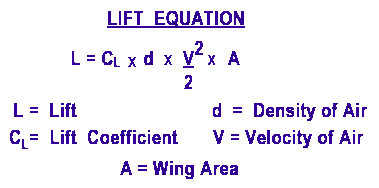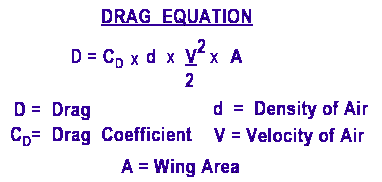Ada empat gaya yang bekerja pada pesawat sepanjang waktu selama pesawat adalah flying.The empat gaya yang
(1) Lift, (2) Gravity force or Weight, (3) Thrust, and (4) Drag. (1) Angkat, (2) Gravitasi atau gaya Berat, (3) Thrust, dan (4) Drag.
Lift and Drag are considered aerodynamics forces because they exist due to the movement of the Airplane through the Air. Angkat dan Drag dianggap aerodinamis pasukan karena mereka ada karena pergerakan pesawat melalui Air.
|
 |
|
Lift:
is produced by a lower pressure created on the upper surface of an
airplane's wings compared to the pressure on the wing's lower
surfaces,causing the wing to be LIFTED upward. Angkat:
dihasilkan oleh tekanan yang lebih rendah dibuat pada permukaan atas
sayap pesawat dibandingkan dengan tekanan pada permukaan sayap lebih
rendah, menyebabkan sayap yang akan diangkat ke atas. The
special shape of the airplane wing (airfoil) is designed so that air
flowing over it will have to travel a greater distance and faster
resulting in a lower pressure area (see illustration) thus lifting the
wing upward. Bentuk khusus dari sayap pesawat (airfoil) dirancang
sedemikian rupa sehingga udara yang mengalir di atasnya harus menempuh
jarak yang lebih besar dan lebih cepat menghasilkan daerah tekanan
rendah (lihat gambar) sehingga mengangkat sayap ke atas. Lift is that force which opposes the force of gravity (or weight). Lift adalah bahwa kekuatan yang menentang gaya gravitasi (atau berat).
|
 |
|
Lift
depends upon (1) shape of the airfoil (2) the angle of attack (3) the
area of the surface exposed to the airstream (4) the square of the air
speed (5) the air density. Angkat tergantung pada (1) bentuk
sudut (2) airfoil dari serangan (3) bidang permukaan terkena persegi (4)
aliran udara dari kecepatan udara (5) kerapatan udara.
|
 |
|
Weight: The weight acts vertically downward from the center of gravity (CG) of the airplane. Berat: Berat beraksi secara vertikal ke bawah dari pusat gravitasi (CG) dari pesawat.
|
Thrust: is defined as the forward direction pushing or pulling force developed by aircraft engine . Thrust: didefinisikan sebagai arah depan mendorong atau menarik gaya dengan mesin pesawat. This includes reciprocating engines , turbojet engines, turboprop engines. Ini termasuk mesin reciprocating, mesin turbojet, mesin turboprop.
|
 |
|
Drag: is the force which opposes the forward motion of airplane. Drag: adalah kekuatan yang menentang gerakan maju dari pesawat. specifically,
drag is a retarding force acting upon a body in motion through a fluid,
parallel to the direction of motion of a body. khusus, drag gaya perlambatan yang bekerja pada tubuh bergerak melalui cairan, sejajar dengan arah gerakan tubuh. It is the friction of the air as it meets and passes over an airplane and its components. Ini adalah gesekan udara saat itu memenuhi dan melewati sebuah pesawat dan komponennya. Drag is created by air impact force, skin friction, and displacement of the air. Drag diciptakan oleh kekuatan dampak udara, gesekan kulit, dan perpindahan dari udara.
|
 |
|
| Aircraft Flight Control Pesawat Penerbangan Kontrol |
An
airplane is equipped with certain fixed and movable surfaces or airfoil
which provide for stability and control during flight. Pesawat
ini dilengkapi dengan permukaan tetap dan bergerak tertentu atau airfoil
yang memberikan stabilitas dan kontrol selama penerbangan. These are illustrated in the picture. Ini diilustrasikan pada gambar.
|
 |
|
Each of the named of the airfoil is designed to perform a specific function in the flight of the airplane. Masing-masing bernama dari airfoil dirancang untuk melakukan fungsi tertentu dalam penerbangan dari pesawat. The fixed airfoils are the wings, the vertical stabilizer, and the horizontal stabilizer. Yang tetap adalah airfoil sayap, stabilizer vertikal, dan horisontal stabilizer. The
movable airfiols called control surfaces, are the ailerons, elevators,
rudders and flaps.The ailerons, elevators, and rudders are used to
"steer" the airplane in flight to make it go where the pilot wishes it
to go. Para airfiols bergerak disebut kontrol permukaan, adalah
aileron, elevator, kemudi dan ailerons flaps.The, lift, dan kemudi
digunakan untuk "mengarahkan" pesawat dalam penerbangan untuk membuatnya
pergi ke mana pilot menginginkan untuk pergi. The flaps are normally used only during landings and extends some during takeoff. Tutup biasanya digunakan hanya selama pendaratan dan meluas beberapa saat lepas landas.
|
Aileron:
may be defined as a movable control surface attached to the trailing
edge of a wing to control an airplane in the roll, that is , rotation
about the longitudinal axis. Aileron:
dapat didefinisikan sebagai permukaan kontrol bergerak melekat pada
trailing edge dari sayap untuk mengendalikan pesawat dalam gulungan,
yaitu, rotasi terhadap sumbu longitudinal.
|
Elevator:
is defined as a horizontal control surface, usually attached to the
trailing edge of horizontal stabilizer of an airplane, designed to apply
a pitching movement to the airplane. Lift:
didefinisikan sebagai permukaan kontrol horisontal, biasanya melekat
pada trailing edge dari stabilizer horizontal pesawat, yang dirancang
untuk menerapkan gerakan pitching ke pesawat. A pitching movement is a force tending to rotate the airplane about the lateral axis,that is nose up or nose down.
Sebuah gerakan Pitching adalah kekuatan cenderung untuk memutar pesawat
pada sumbu lateral, yaitu hidung atas atau hidung ke bawah.
|
Rudder:
is a vertical control surface usually hinged to the tail post aft of
the vertical stabilizer and designed to apply yawing movement to the
airplane, that is to make it turn to the right or left about the
vertical axis. Rudder:
adalah permukaan kontrol vertikal biasanya berengsel ke pos ekor
belakang dari vertical stabilizer dan dirancang untuk menerapkan gerakan
yawing ke pesawat, yaitu untuk membuatnya turn ke kanan atau kiri pada
sumbu vertikal.
|
|
 |






